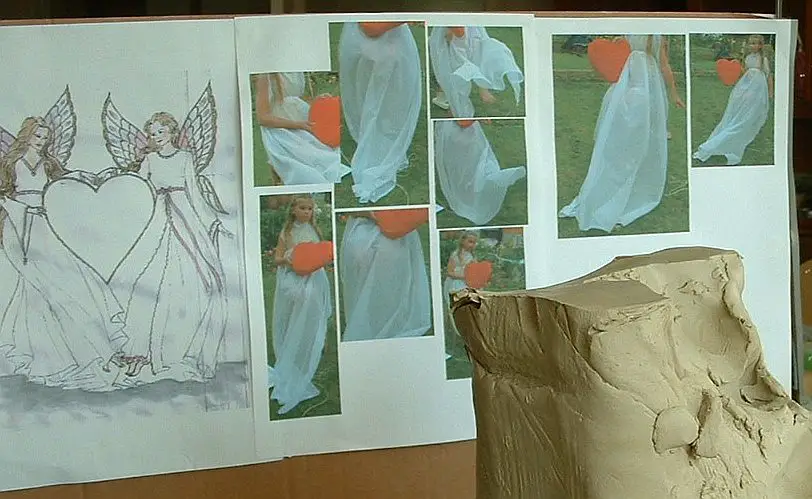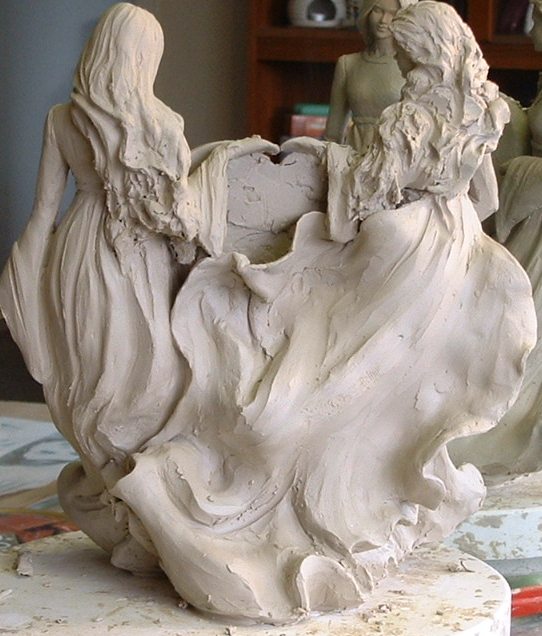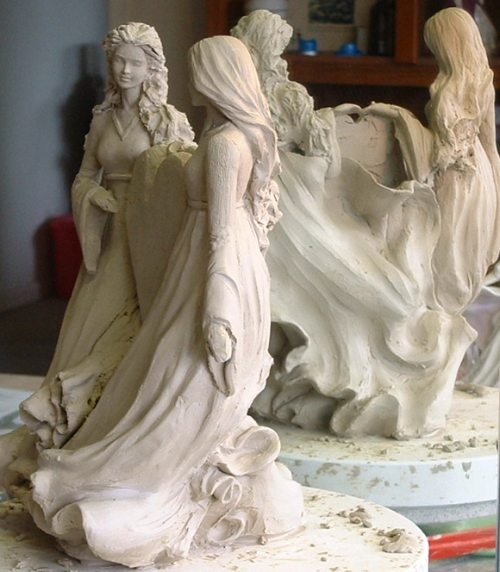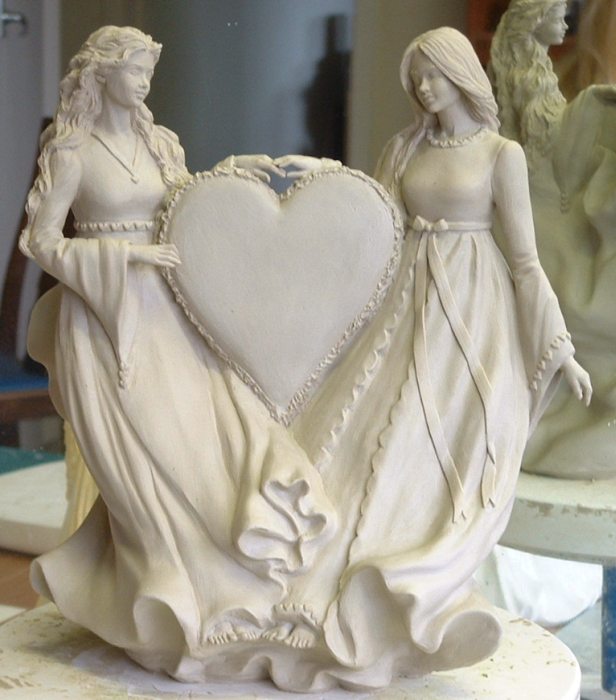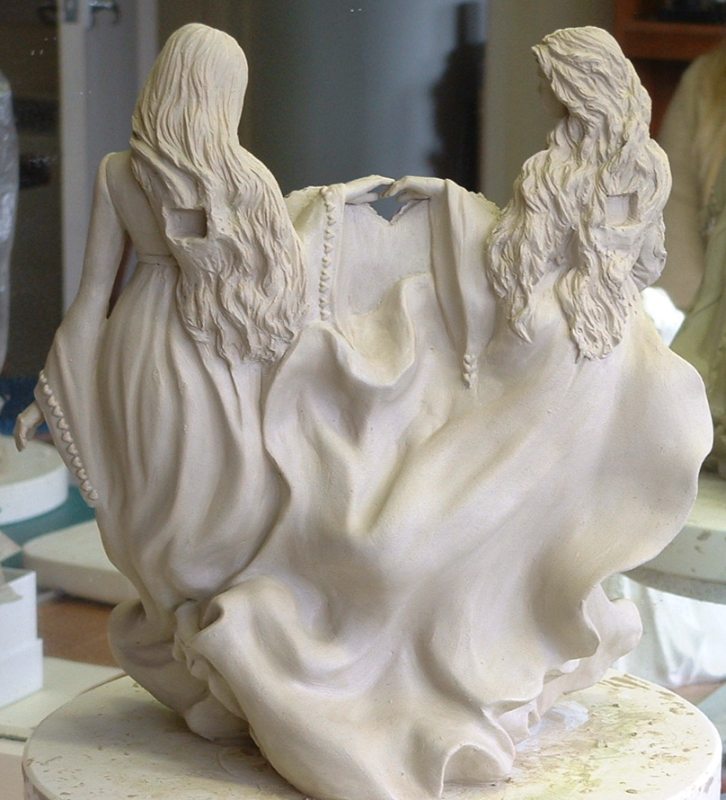A Sculpture Lesson on Ceramic Clay
Creating a clay model from start to finish
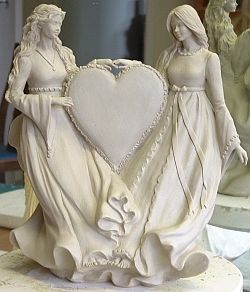
This clay sculpture lesson shows how to plan and make a pair of angels in ceramic modelling clay from start to finish.
(see photo left)
The finished piece was not intended to be fired, but was for the making of a 'master-mould' for slip-casting bone china production.
The aim is to de-mystify the process by demonstrating a systematic, professional approach.
Break it down into bite size pieces and chew slowly, is one way to describe it.
The stages shown in this article are as follows:-
This 'Two Angels' piece was not of my design, but a commission given to me
by a marketing firm.
I only tell you this to say that, although I am pleased with the result, this article is more about technical information than the 'artistic process' as such.
Skip to main content of this sculpture lesson....
1. Prep
Get comfortable. Get references together.
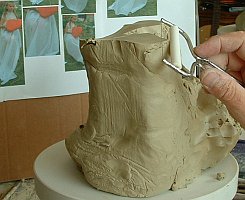
In my view, working with a correct posture is important, and for that reason, I like to work with 2 different turntables, one higher, one lower - and either an adjustable height chair or table or both
...more about working posture here
I always use a damp bat made from plaster of Paris as the platform on which to build my sculptures.
The references as well as the sculpture should be right in front of the eye-line. I make sure they are
good ones and they are right there where I can't miss them ....more on how to prepare references here
For this piece, I needed some really specific floaty images, so I dressed one of my daughters up as an angel (type-casting!) and let her float around a bit. I sometimes photograph my own references, and sometimes take images from magazines.
The sketch on the left of the photos of my daughter is the brief I was asked to reproduce in clay (drawn by another artist).
Now it's time to put the first bit of clay on a damp plaster bat on the turntable and go.
Sculpting lesson tip:- anchor the piece to stop it moving around by drilling a small hole through the bat and place a nail up through the bat and the sculpture. Not very high tech - but it works fine.
2. Roughing
At this stage in the sculpt, it is now all about measurement (unless your name's Michelangelo and you do everything by eye).
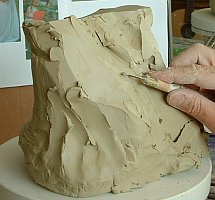
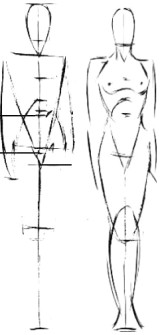
I measure, referring to a drawn up scale guide (like a pin-man on paper) so I can constantly refer with my dividers.
With my anchored lump of clay on the bat, I measured and marked off heights of where the top of the head, the shoulders, hips, knees etc would be going.
On the angel figurine I knew that the top of the lump of clay I had put on the bat was precisely where the waist of the angels were going to be.
How did I know?....... I measured.
You may be suspecting by now, the main thrust of this sculpture lesson so far is to be precise with measurements in the early stages.
3. Hook
Once the roughing out and measuring is marked on the lump of clay, it is time to start shaping it.
The 'hook' is my name for the place within the sculpture you start the slow process of not making it not look like a lump of clay anymore.
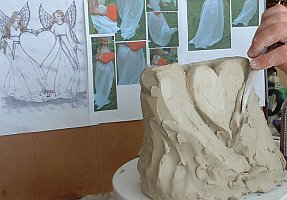
A lump of clay is a daunting thing to many people, including me, so I need that 'hook' to help my eye see what my mind is already seeing - a focus for the imagination to start working.
The eye can then instruct the hands and tools to start carrying out its wishes.
With the sculpt of the two angels, the visualisation or 'hook' was the central heart shape.
Once the heart shape was roughed out, I started to get a feeling for the shape of the dresses around each side of the heart. At this point it is all about feeling your way around the sculpture - making little positive visualisations.
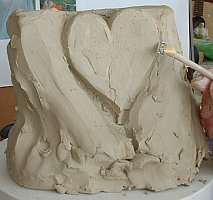
It may not look much to you from the photo, but for me I could now suddenly see how the lovely flowing robes could be developed from the shapes in the clay either side of the heart. The piece was no longer just a stubborn lump of ugly clay, it had started to morph.
I have talked to some artists who say they love the tactile nature of clay and it inspires them, blah blah... Not me. In the first instance, it is always a cold, wet, clumsy, slow, annoying, inert piece of slippery ugly mud that isn't helping at all. I have to visualise the clay going from being 'the enemy' to working for me.
The hook is the thing which begins the conversion.
4. Add Parts
So using the hook and a bit of imagination I can now start to 'see' the design, and can continue the conversion.
I know where things are going to go because I have measured and marked.
So now it's time to go all round the piece removing bits that shouldn't be there and adding the parts that should. Some of the bits that should be there are two female upper-body torsos.
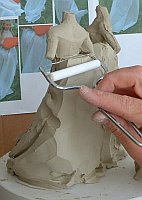
I had prepared the roughs for these as separate parts. I knew they were the right scale - I had very carefully measured against my scale diagrams.
Again, where they were placed was worked out by careful and precise measuring.
If this whole sculpture lesson seems, so far, more of a technical exercise than an artistic one, that would be correct.
Being systematic and precise at this early stage simply paves the way for later artistic interpretation. It saves all the time wasting of changing a model because the proportions are wrong.
So in that same vein, now I place on the heads I prepared earlier.
These torsos and the heads, prepared as separate parts were just ready to simply place on. They were by no means finished, but again, it was a good starting point to begin to work on the overall composition.
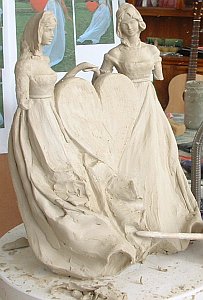
5. Composition
Now the essential elements are in place and definitely the right scale, it is at last time in this sculpting lesson to get into the composition proper.
Having done the hard grunt work, we are now allowed to get a bit arty.
If you are anything like me, this will be the bit you have been waiting for. It reminds me of doing interior design once the structure of the house is built. The difference is...... you build the house too!
This is party time. Time for exuberance and self-expression. For example, I love doing hair. I use lots of very wet clay and fold it in with tools and brushes - then let it dry for a day or two while I work on something else.
In this instance I had to figure out what was happening at the back. I wasn't sure what I was going to do here, I didn't have any references (a major problem for the part of my brain that feels naked without references). I felt a sweeping train maybe needed to go onto the back of this figurine.
So, I just improvised by rolling out a slab of clay and mucked around with it for not very long - and was reasonably pleased with what came out, so had the wisdom to stop. Sometimes you need to know when not to over-work something.
The folds on an angel's cloak out of sight on the back of a sculpture, could have many different solutions, so don't sweat it too much.
The shape of a female arm (quite a complex yet specific series of planes) needs to be worked on until it is totally right, no matter how long that takes; BUT.... not yet, when the time comes (in the detailing segment later). Meantime, the angels can have approximate arms, and your newly found skill of positive visualisation can do the rest.
So this part can be fun. Who needs food or sleep? Humans can work for really long periods when in this frame of mind. This is when the donkey work is done, and it can be done quite quickly at this stage, because the foundations have been laid correctly.
6. Detailing
In this sculpture lesson I am going to talk about broader principles when it comes to detailing, as there is a separate article on how to add fine detail with ceramic clays ....more
The principle to talk about here is that detailing only begins in earnest once the overall composition is finalised.
The very last thing I want to happen is to carefully place on lots of intricate time-consuming details only to have to scrape them all away because there is something to change within the composition.
I ask friends, colleagues and others I trust to give a fresh eye. Don't punch them if they say something is awry, embrace them and their comments. Something inside was likely already telling you the same, but you weren't quite listening.
By 'composition' I mean how the piece flows. Are there any awkward angles, are the arms looking in the right position etc etc.
I can look at the finished angel sculpt now and be critical. Unfortunately, it's too late, I got my fee and moved on.
One of the most important things to take from this sculpture lesson is I DID NOT START DETAILING UNTIL I KNEW I WAS NOT GOING TO CHANGE ANYTHING ANYMORE.
Before, I put on any detailing on any model, I always get the client's product development team to OK everything about the composition. If they then want to fine tune anything about the composition after I have done detailing and it has to be re-done, they get charged an extra fee.
Addendum to sculpture lesson:-
The wings were made as separate pieces from slabware (rolled out slabs of clay). They were kept separate from the main sculpture, as they would probably have needed an armature to stay put in transit.
Summary of this Sculpture Lesson
The idea of going through a piece from start to finish is one that many people said they would find helpful.
Of course, I could have created a time lapse video. There are many of them on YouTube. The problem with a sculpture lesson of this sort is that a time-lapse type presentation in no way gives an inkling of the mental processes involved in making a clay sculpture.
And making a clay sculpture is primarily a mental process. It's about getting your mind right, rather than simply having two eyes and a pair of hands.
So, for that reason, with this sculpture lesson, I tried to give an idea at least of the processes, both mental and physical that you need to go through in a systematic way if you are to be able to create even a reasonably competent and complex figurative piece.
Return from sculpture lesson to homepage or alternatively back to clay sculpting
